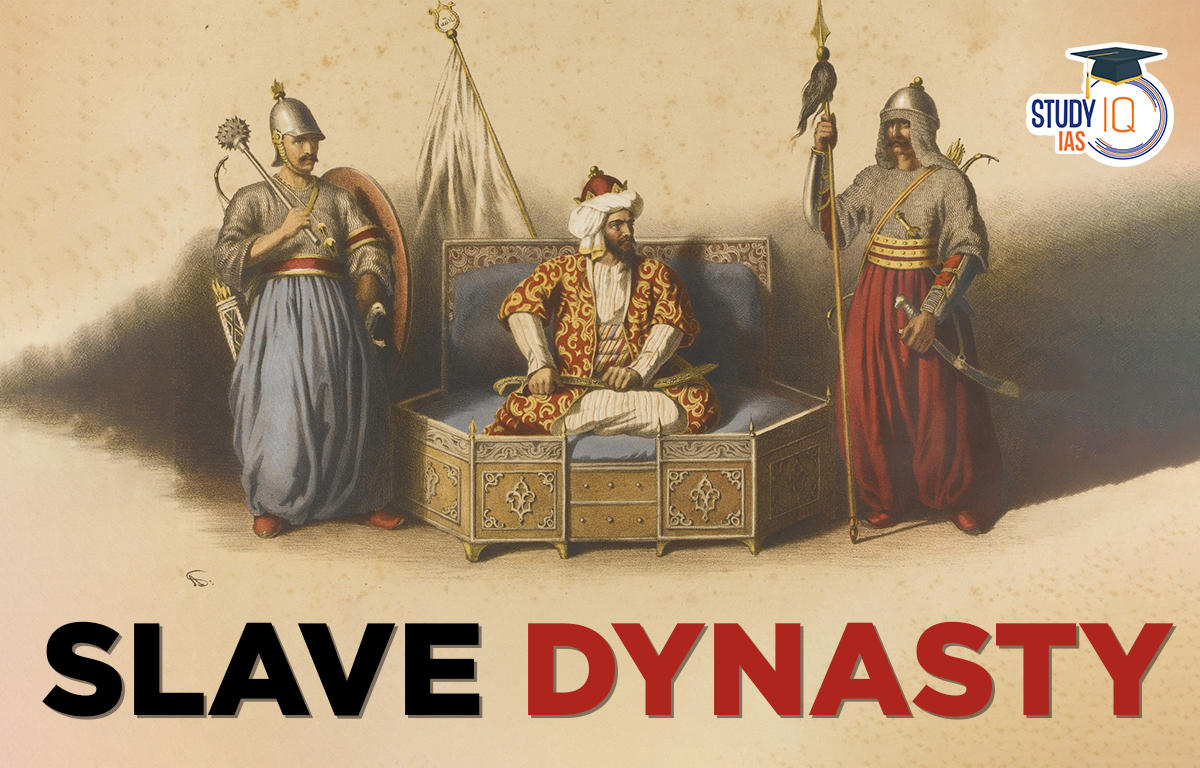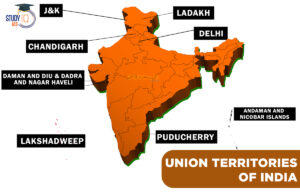Table of Contents
Slave Dynasty
The Delhi Sultanate was first ruled by the Slave Dynasty. The Mamluk empire is another name for the Slave dynasty. Qutb-ud- Din Aibak established the Mamluk empire in Delhi. “Mamluk” indicates “owned” in Arabic. Around the ninth century CE, in the Islamic realm of the Abbasid Caliphs, the Mamluk emerged as a potent military class. Egypt was under the military and governmental control of the Mamluks. High-ranking commanders, army generals, and soldiers were referred to as slaves during that time. They had given their masters their entire existence. Consequently, that is where the term “slave” first appeared. This article has all the details related to the Slave Dynasty important part of the History of UPSC Syllabus.
Slave Dynasty Origin
The Slave Dynasty was founded by Qutb ud-Din Aibak. The family reigned between 1206 and 1290. The Delhi Sultanate reigned over this first dynasty. The Mamluk Empire came to an end in 1290 when Jalal-ud-din-Firuz Khilji (Jalal ud din Firuz Khilji) overthrew Muiz ud din Qaiqabad. The Khilji (or Khalji) family, the second dynasty of the Delhi Sultanate, inherited the dynasty.
Other names for the Mamluk Empire include the slave dynasty. Mamluk, which means “owned,” alludes to a strong military caste that first appeared in the Abbasid Caliphate Islamic Empire in the ninth century AD. In Egypt, Iraq, and India, the Mamluks hold both military and governmental sway. Although they are slaves, their owners place a high value on them. The majority of them are soldiers and generals battling for their superiors. The Mamluk Dynasty was founded in Delhi by Qutb-ud-Din Aibak.
Slave Dynasty Founder
Qutb-ud-Din Aibak was the creator of the Slave Dynasty. From 1206 A.D., he was Delhi Sultan. He was a member of a Turkish household living in Central Asia. Muhammad Ghori (Ruler of Gur in Afghanistan) received him as a prisoner. Everyone in the palace, including the ruler, was a fan of the Aibak’s artwork. In addition, he was given a promotion and appointed Ghori’s commander, the general with the highest level of confidence.
Aibak proclaimed himself the Sultan of Delhi in 1206 and was the first king of the Slave Dynasty following the murder of Muhammad Ghori. The Quwwat-ul-Islam shrine in Delhi, one of the earliest Islamic structures, was built by him. During his early years of rule, work also started on the Delhi Qutub Minar. Due to his generous character, the people of the kingdom gave him the name “Lakh Bash,” which means a gift of lakhs. In 1210, he perished. He was replaced as the second ruler of the Slave Dynasty by Aram Shah.
Also Read: Mahmud of Ghazni
Slave Dynasty Rulers List
Below given is the complete list of Slave Dynasty Rulers:
| Name of the Ruler | Timeline |
| Qutb ud-Din Aibak | (1206-1210 AD) |
| Aram Shah | (1210-1211 AD) |
| Iltutmish | (1211-1236 AD) |
| Rukn-ud-din Feroze | (1236 AD) |
| Razia al-Din | (1236-1240 AD) |
| Muiz-ud-din Bahram | (1240-1242 AD) |
| Ala-ud-din Masud | (1242-1246 AD) |
| Nasiruddin Mahmud | (1246-1266 AD) |
| Ghiyas-ud-din Balban | (1266-1286 AD) |
| Muiz-ud-din Muhammad Qaiqabad | (1286-1290 AD) |
Slave Dynasty and Qutb ud-Din Aibak
Qutb-ud-Din Aibak unintentionally perished in Lahore in 1210 AD while playing Chaugan. (a form of Polo). Aram Shah followed him. He was a poor leader. He was thought to be Aibak’s kid. He was in charge of Northern India’s Ghurid area. A group of nobles acted the role of his assassins. This party favoured Shamsuddin IItutmish as monarch. Illtutmish was Aibak’s son-in-law and a native of Central Asia. The best renowned slave ruler in Delhi is IItutmish. He made Delhi the new capital, moving it from Lahore.
Approximately 25 years of Iltutmish’s reign saw the Delhi Sultanate grow in size. Along with extending his territory, he made significant contributions to societal welfare. In 1205, Razia Sultana, an Iltutmish descendant, was born. As the first and last woman to govern Delhi, she made history. The other name for Razia Sultana was Razia-al-Din. Rukn-ud-din Firuz, Razia Sultana’s half-brother, succeeded to the crown after Iltutmish passed away. A group of elites planned to assassinate him in order to install Razia on the throne.
Razia Sultana was a capable leader who was well-liked for her impartial decisions. Razia Sultana was married to Malik Ikhtiar-ud-din Altunia, the ruler of Bathinda. Her brother Muizuddin Bahram Shah, who succeeded to the throne after her demise, sent troops to plot against her. The slave dynasty’s ninth Sultan was Nasir-ud-din-Mahmud. His birthplace was Turkey. He went by the moniker Bahauddin. Nasir-ud-din-Mahmud was purchased as a slave by Iltutmish. He subsequently received a promotion and was given permission to conduct military campaigns as a military officer.
Barban, who lacked any male successors after Nasir’s passing, proclaimed himself Sultan. He continued to oversee the military, the government, and civil reforms. Balban was referred to as the strict ruler because of his austere behavior and rigid obedience to the king. Balban had a good spy system in place to control the nobility and he only meted out the barest of punishments to his subjects. In Navroz, India, he made the Persian celebration more well-known.
Slave Dynasty and Iltutmish
Aram Shah is a despotic leader. A group of nobles plotted against him and invited Shamsuddin Iltutmish to govern. The father of Iltutmish is Aibak. He was in charge of northern India’s Gurid area. Turkic captive Aram Shah was born in Central Asia. Delhi’s best slave lord is lltutmish. He relocated Delhi’s capital from Lahore.
In 1210, lltutmish’s troops invaded Bangladesh, and in 1225, they occupied Bihar. Itltmish ignored the Indus Valley during the first half of the 1220s, when it was in conflict with the Mongols, King Khwarazm, and Qabacha. Kabacha assumed control of the region following the demise of the Mongols and the danger posed by the Khavarazmi, but Iltumtmish invaded his domain from 1228 to 1229. He protected his empire from Rajput intruders as well as Mongol invaders.
He put a halt to Genghis Khan’s 1221 invasion. The Quwwat-ul-Islam Mosque and the Qutb Minar Mosque were both finished by him. He created the kingdom’s executive branch. Delhi was made suitable as a center of power by the mosques, water plants, and other facilities he constructed there. He introduced the silver tanka and copper metal as the two official Sultanate currencies. The Iqtadari system, which divided the kingdom into Iqtas and assigned them to the nobles in return for pay, was also implemented. He felt that his son was unqualified for this position, so when he passed away in 1236, his daughter Razia Sultana received the inheritance.
Mamluk Dynasty and Razia Sultana
Razia Sultana a daughter of Iltutmish was born in the year 1205. Her father attended a reputable university. She was Delhi’s first and last Muslim monarch. Razia al-Din is another name for it. After his father’s demise, her half-brother Rukn-ud-din Firuz temporarily took over as king of Delhi before ascending to the throne. However, the nobility decided to install Razia on the throne after Firuz was killed six months after his murder. She is regarded as an effective and impartial leader. She wed the governor of Bathinda, Malik Ikhtiar-ud-din Altunia. She allegedly died at the hands of her brother’s soldiers. Her inheritance went to her sibling Muizuddin Bahram Shah.
Slave Dynasty and Ghiyas-ud-din Balban
Ghiyas-ud-din Balban followed Razia as a well-known leader. He was the ninth Mamluk dynasty ruler. He is Wazel, the grandchild of Iltutmish and Nasir-ud-din-Mahmud. His birth name is Bahauddin, and he was born in Turkey. Iltutmish purchased him as a slave. His promotion came swiftly. As an officer, he led military operations with distinction. Barban proclaimed he was sultan after Nasir died because he lacked male children.
He implemented military and civil reforms in administrative administration, which helped him surpass Iltutmish and Alauddin Khalji as the second-largest ruler of the Sultanate. Barban was a stern leader, and his court served as a representation of frugality and rigid allegiance to the monarch. Even before the monarch, he urged people to submit. He gives his victim the lightest punishment possible.
To manage his nobility, he employs a spy system. In India’s Navroz, he brought the Persian festival. During the Punjabi reign, there was a significant amount of conversion. His grandson Qiqubad succeeded to the Delhi throne after his demise. The Mamluk dynasty was ending and being replaced by the Khalji dynasty when Quaiqubad passed away from a stroke in 1290. He was succeeded by his three-year-old son Shamsuddin Kayumars, but they were both killed by Jalal ud-Din Firuz Khalji.
Slave Dynasty Contribution
In the fields of art and building, the Slave Dynasty Sultans made contributions. In Delhi, Qutb-ud-Din Aibak founded the Quwwat-ul-Islam shrine. In Ajmer, he also constructed the shrine known as Adhai Din Ka-Jhonpra. He also oversaw the beginning of the Qutb Minar’s building. He made Khwaja Qutbuddin Bhaktiyar Kaki, a Sufi saint, the subject of this website. The Quwwat-ul-Islam shrine was built with assistance from Iltutmish. He is also attributed with helping the Slave dynasty get off to a strong start.
Tanka, a brand-new coin presented by Iltutmish, was also created. The entire Qutb Minar was constructed during his reign. Ghiyas-ud-din-Balban was a successful leader who spent a lot of time enhancing government. The grandeur of this emperor, who was renowned for his dignity, has been celebrated by numerous poets. He was so devoted to his faith that he always wore traditional clothing in front of his personal assistants.
Poems and artworks produced during Ghiyas-ud-din-Balban’s reign demonstrate the creativity’s growth during this time. Poets and painters were once employed as slaves by the emperors. The chalgan, also known as the forty, was the most well-liked organization created during the Slave dynasty. The strong, high-profile corps was referred to as “Chalgan”. They served as Iltutmish’s closest allies. The emperor’s cabinet was made up of these chalgans, who proposed various policies and planned strategies during the civil war but progressively undermined the government by forgoing their favors. Because of their position of power, they began referring to themselves as “deputy of the sultan.”
Mamluk Dynasty Last Ruler
Jalal-ud-din Firoz Khilji, who deposed the last Mamluk ruler Muiz ud din Qaiqabad, he destroyed the Slave Dynasty (in 1290). The Slave Dynasty reigned from AD 1206 to AD 1290, and its last ruler was Muiz-ud-din Muhammad Qaiqabad.
Decline of Slave Dynasty
Within a century, the Mamluk dynasty’s reign came to an end. Khaljis emerged following the fall of the Mamluk Empire. The Slave Dynasty was forced to collapse due to a number of factors. The Slave Dynasty Sultans described themselves as being from abroad. The people of India did not then enjoy the same sense of unity and harmony. Hindus began plotting to overthrow Muslim authorities. Chaos and uncertainty were brought about by the Hindus’ treachery toward the Sultans, making it challenging for the Sultanate to maintain control over the Kingdom’s populace.
The centre was given tremendous authority by autocratic military rule. The governors of the provinces received no privileges. They behaved like the Sultans’ puppets, and their ability to remain in the court relied on their ability to carry out their instructions. This had an impact on their advancements and downgrades. The Mamluk Sultans asserted that they were descended from God on earth during the reign of the dynasty, which also adhered to the divine right doctrine. The participants disagreed with this hypothesis. This conflict resulted in the Mamluk dynasty’s collapse.
Slave Dynasty UPSC
The Sultans in India depended on Muslim Amirs for their survival. The Muslim Amirs were honoured with gifts and high posts by the Sultanate. Military security and financial aid were given to them in return. They were powerful as well, such authority made them ‘The forty’ which increased the power of the Amirs. Later on, they started neglecting the will of the king. Iltutmish wanted Razia to sit on the throne but by sources Muslim Amirs enthroned Ruknuddin. The rising power of the Muslim Amirs contributed to the decline of the Slave dynasty. This article has all the details related to Slave dynasty for more details about UPSC Exam preparation candidates can visit to the official website of StudyIQ UPSC online Coaching.


 Indian Sex Ratio 2024 State-wise, NFHS-5...
Indian Sex Ratio 2024 State-wise, NFHS-5...
 Union Territories of India with Capital ...
Union Territories of India with Capital ...
 Rowlatt Act 1919, Meaning, Provisions, R...
Rowlatt Act 1919, Meaning, Provisions, R...

















